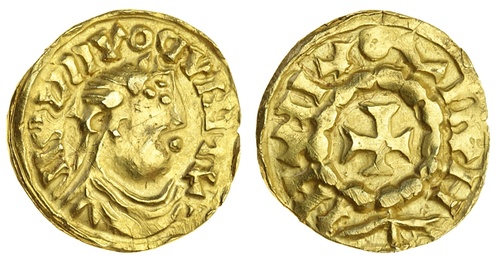
Auction: 20004 - British Coins and Commemorative Medals: Spring Auction - conducted behind CLOSED DOORS
Lot: 13
Anglo-Frisian, in the style of Louis the Pious (c. 814-840), gold Solidus, c. 816-818, 3.99g, 6h,
Found in the Aldingbourne, Arun District, West Sussex, 5 May 2019
Whilst coinage in Northern Europe and England in the eighth and ninth Centuries was predominantly silver based, there is now extensive evidence of the concerted attempts made towards a regular gold coinage during this period as well. More than 120 coins are now documented with most traditionally contextualised by find spots on the near continent. However the combination of mutually-beneficial laws and the uptake in hobbyists undertaking metal detecting has swelled the numbers of examples recorded from the British Isles, with notable recent discoveries including Coenwulf of Mercia's gold Mancus (Spink 170, 6-7 October 2004, lot 493). They remain however very rare finds, especially in a British context. The majority of those found are modelled on the gold Solidus introduced by Merovingian dynast Louis the Pious (c. 814-840) whose coinage came to be imitated extensively in the North Sea area. Most surviving examples of these come from three hoards found in the Netherlands, however a small group are thought to derive from native production in the British Isles. This new find re-emphasises the growin acceptance of gold specie in circulation in England alongside the contemporary silver Penny. Previous debate has valued these imitation Solidii and the Mancus to 30 silver pennies; both gold coins being of similar weight (c. 4.4g) and the gold to silver ratio being approximately 9:1 at the time. Interestingly however, this coin scales approximately 10% lighter, but still remains comfortably within the boundaries of Grierson's wider study group (cf. types IV(c) [3.585g] and XX(a) [4.04g]) and similarly compares favourably against the recorded weights of seventeen examples recovered from the Delfzijl Hoard (1906), even though Grierson later contested these initial findings.
This is therefore the twenty-second example of an Anglo-Frisian imitation Solidus in the style of Louis the Pious recorded for Britain (EMC/PAS). Of these, sixteen are full coins, four are cut, fragmentary or quartered, and two are base silver or base copper alloys respectively. There is also a lead 'trial' piece found at Torksey in 1997 that would suggest that some of these isolated discoveries may also once have been struck in England (cf. Grierson type XVI). Notably the Torksey and wider West-Lindsey district has been the site of at least three further discoveries of Solidii, including two Anglo-Frisian imitations (EMC 2014.0250 ~ Spink 227, 17-18 December 2014, lot 484) and a quartered fragment weighing 0.90g (EMC 2010.0127); as well as an 'official' Frankish issue, subsequently quartered, 1.16g (EMC 1997.0101 ~ Spink 126, 14 July 1998, lot 270 ~ Fitzwilliam Museum, not listed here). Of the sixteen full coins, a further three exhibit subsequent piercing for jewellery mounting, leaving thirteen intact specimens for study, six provenanced to the 19th Century and the remainder individual discoveries since the wider uptake of metal detecting as a hobby in the 1980s.
The corpus of Louis the Pious imitation Solidii found in England therefore can be updated from our 2009 sale as follows. Those thought to be Frankish 'official' coins are not recorded here:
1. Fitzwilliam Museum, Cambridge. [EMC 1986.8753]. Found in the River Cam, Cambridge (by 1876), 4.30g, same dies as 2 and 3.
2. Ashmolean Museum, Oxford. [EMC 2001.0515]. Found at Lewes (1884), 4.33g, same dies as 1 and 3.
3. British Museum. [EMC 2001.0501]. Found at Therfield, near. Royston, Hertfordshire (before 1860), 4.59g, same dies as 1 and 2.
4. [EMC 2001.0522]. Sotheby, 25 March 1850, lot 247. Found Portchester, Hampshire (1832), untraced.
5. Southampton Museum. [EMC 1992.9424 and 2001.0526]. Found during excavations around Southampton (1971-86), 4.56g.
6. Richard Falkiner [EMC1986.0537]. Christie's auction, 17 November 1970, lot 46a. Found at Stamford Bridge, Yorkshire (early 1940s), 4.08g.
7 [-]. [EMC 2001.0448]. Found at Elgin (by 1864), 4.31g.
8 [-]. [EMC 1999.0154]. Found at Kirk Maughold (1884), weight not recorded
9 [-]. [EMC 1995.0127]. Found in Gainsborough and Lincoln area (early 1995), 4.06g.
10 [7]. Numismatica Genevensis SA 6, 30 November 2010, lot 417, Lockdale's auction 70, 29 January 2009, lot 810. Probably Found in Norfolk (late 2008), 4.22g.
11. Private collection in North America. [EMC 2009.0157 // PAS WILT-A50F43]. Spink 199, 25 June 2009, lot 476. Found near Salisbury, Wiltshire (March 2009), 4.42g.
12. Fitzwilliam Museum, Cambridge. A cut half. Lockdale's auction 75, 15 November 2009, lot 480. Found at Mendlesham, Suffolk (before October 2009), Grierson, class XIV. 2.08g, 55% Gold.
13. Fitzwilliam Museum, Cambridge. [EMC 2010.0127]. A cut fraction [1/6th coin]. Found near Torksey, Lincolnshire (March 2010), 0.90g.
14. [EMC 2013.0227]. A cut half. Found at County Down (2013), 1.73g.
15. [EMC 2014.0157 // PAS SF-5DE284]. Found near Eye, Suffolk (May 2014), 4.03g
16. [EMC 2014.0250 // PAS LANCUM-9E265D]. Spink 227, 17-18 December 2014, lot 227. Found near Bucknall, West Lindsey area, Lincolnshire (7 August 2014), 4.36g.
17. [EMC 2018.0044]. A broken half. Found near Durham (2009), weight not recorded.
18. [EMC 2018.0005//PAS SF-DC15C9//BM 2015T601]. Pierced at obverse 12 o'clock. Found at Barham, near Ipswich, Suffolk (28 July 2015), 3.81g
19. [EMC 2018.0139]. A base silver copy, heavily chipped. Found at Chellaston, Derbyshire (by mid-2018), weight not recorded.
20. [EMC 2018.0387]. Found Lincolnshire (3 November 2018), no weight recorded
21. [EMC 2019.0240//PAS SUSS-2A93DC], this coin
22. Fitzwilliam Museum, Cambridge. [EMC 2013.0106//PAS ESS-8DB9E4]. A gold-plated copper alloy core. Donated to the Fitzwilliam by the finder after recording (found 29 April 2013), 3.61g.
Subject to 20% VAT on Buyer’s Premium. For more information please view Terms and Conditions for Buyers.
Sold for
£10,000
Starting price
£10000




